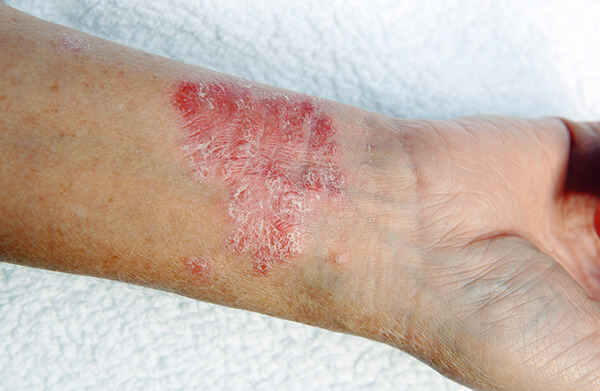PsA
FACT
Psoriatic arthritis symptoms
Psoriatic arthritis (PsA) is a chronic, inflammatory disease that can cause irreversible joint damage and affect other parts of your body, so it’s important to discuss your symptoms with your doctor. The sooner psoriatic arthritis is
the sooner it can be managed appropriately.
Psoriatic arthritis symptoms include skin symptoms like red, scaly skin patches known as skin plaques, as well as joint symptoms like joint pain and swelling. Because joint symptoms in PsA can appear after skin symptoms, some people who actually have PsA may be diagnosed with psoriasis (Ps). Additionally, psoriatic arthritis symptoms usually flare and then diminish, vary from person to person, and can change locations in the same person over time.
Common symptoms of psoriatic arthritis may include:

Psoriatic arthritis typically affects the ankles, knees, fingers, toes, and lower back—and can cause joint damage if not treated appropriately. People with PsA may experience joint pain, swelling, and tenderness in one or more joints, as well as stiffness—particularly in the morning or after a period of rest.
The impact of psoriatic arthritis symptoms
The pain and discomfort of red, scaly skin patches as well as the joint pain, swelling, and stiffness of psoriatic arthritis can have a negative impact on your
—making even your regular, daily activities difficult. PsA can make it difficult to find a comfortable sleeping position. Upon waking up in the morning, some patients experience stiffness that can last more than 30 minutes. Additionally, if the joints of the feet, ankles, or knees are affected, routine tasks like walking or getting out of a chair can be painful.
If you've experienced any of the symptoms above and/or are having trouble doing things like getting out of bed, cutting your own food, combing your hair, brushing your teeth or buttoning your clothes, tell your doctor.
Watch This 15-Second Video – Then Take the PsA Symptom Quiz
Find out if your skin and joint symptoms could have something in common: psoriatic arthritis.

About 1 in 3 people with psoriasis may develop PsA. People with PsA may also have other conditions involving the eyes, heart, and/or GI tract.
Other conditions that are associated with psoriatic arthritis
In addition to psoriasis, some people with PsA may have diseases that have been shown to be associated with PsA, including:
Heart disease
Obesity
Eye disease (uveitis—an inflammatory condition)
IBD (inflammatory bowel disease, like Crohn’s disease and ulcerative colitis)
If any of these symptoms seem familiar, talk to your doctor.
Get a FREE Kit with Recipes and More
Sign up to get a helpful resource with easy recipes, tips, a symptom tracker, and more to help you live well with PsA.
Find a Psoriatic Arthritis Doctor
Find a doctor near you who can help you treat psoriatic arthritis.










